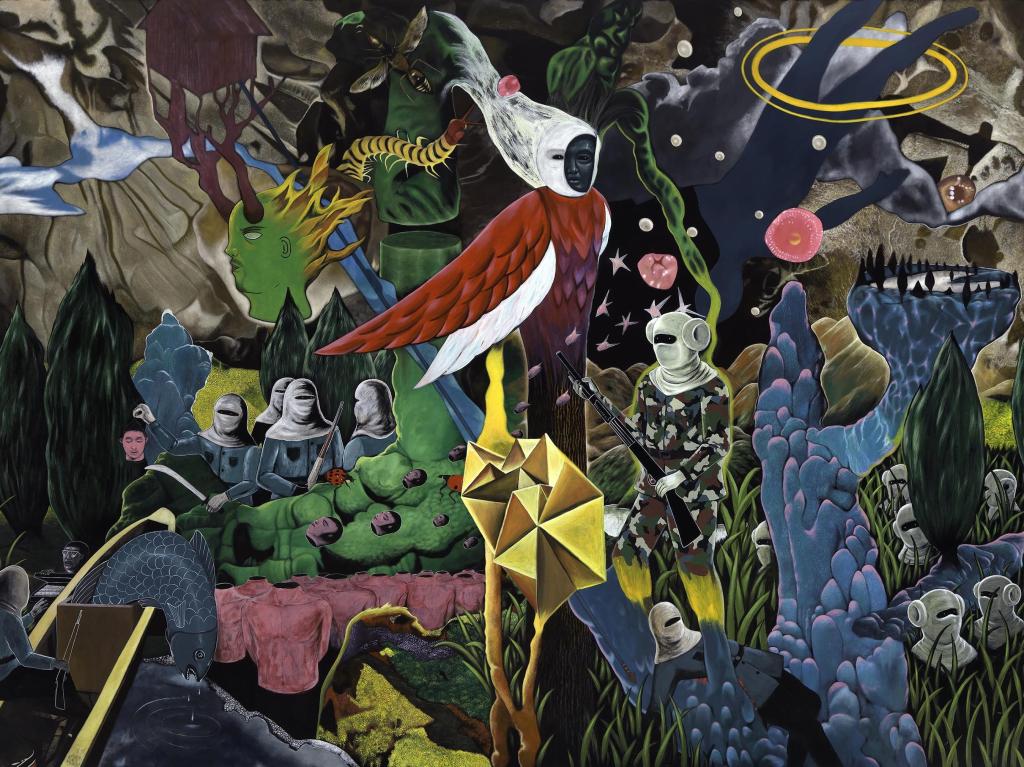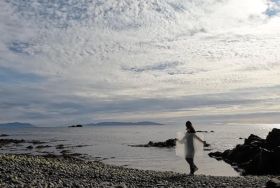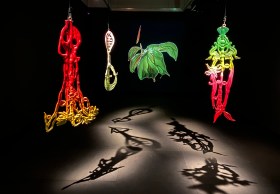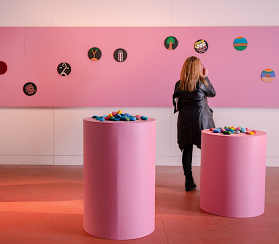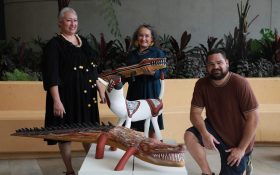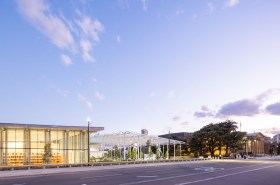Rodel Tapaya, The promise land: the moon, the sun, the stars 2016 (detail), acrylic on canvas. Proposed acquisition.
In April this year, our Visual Arts Editor wrote the article ‘NGA not so cutting edge with Filipino art‘ as an opinion piece about the current curatorial zeitgeist of Filipino programming in Australia; it was not intended by the author to be read as a review of Rodel Tapaya’s exhibition at the NGA or an investigative critique of the NGA’s Contemporary program. That Tapaya’s exhibition was the first in a spate of exhibitions this year was the reason for Ms Fairley’s focus. She spent a decade of her career living, curating and writing in the Philippines prior to starting at ArtsHub. ArtsHub respects the freedom of speech of artists, curators and writers. Here, Kirsten Paisley, Deputy Director, NGA, responds to the original article of 4 April 2017.
* * *
I write in response to ArtsHub’s 4 April 2017 opinion piece and review of Rodel Tapaya’s exhibition at the National Gallery of Australia. The article suffers from a problem best described as ‘The Phenomenon of Colonial Firsts’, or, as expressed by the author, NGA being ‘late to the party’. This is an attitude which suggests institutions need to validate their programs by being the first to ‘discover’ an artistic phenomenon, whether it be an emerging art scene, artist or milieu. It presumes the role of art institutions in regard to Asia is one where primacy is granted to the hitherto undiscovered contemporary subject. Further, that any institution engaging with art work or an artist already unearthed to Australian audiences, is imitating and for that needs to be reprimanded.
Fairley’s article positions the curatorial project as one of discovering the new aesthetic wonders of contemporary South East Asia. This arguably neo-colonial position fails to recognise the often-extended careers of those artists within Asia and elsewhere, and does not account for great artistic developments and artists who justifiably have work exhibited in more than one state in any given decade. Further this standpoint fails to recognise the variety of projects undertaken by national cultural institutions, and the multiple different purposes they fulfil. A single work being shown as it enters a collection, or in Tapaya’s case his inclusion in the Sydney Biennale, should not inhibit a subsequent solo presentation or major survey.
Australia has an important role to play in the creation of opportunity for artists and audiences with respect to contemporary art in our region. This is a shared role across major institutions, contemporary art spaces and artist initiatives. When the NGA engages in contemporary art from the Asia-Pacific region, audiences have only to gain from that opportunity. Equally, arts readers have only to gain when reviewers are actually part of that audience.
It is unusual that a journalist levels acerbic criticism at an exhibition they have not seen, and at a curatorial team whom they’ve not met. Yet the author criticises Senior Curator Jaklyn Babington for not having travelled to the Philippines by way of research for Tapaya’s exhibition. The assumption here is that travel to an artist’s country is a necessary requirement for adequate research. This expectation is rarely an issue when considering international artists outside of Asia, such as Jim Lambie’s fabulous architectural intervention presented in the foyer of the NGA in 2016, or Pippilotti Rist’s immersive video presentation Worry Will Vanish Revelation (2014). If Fairley had travelled to Canberra to undertake her own research, it may have revealed that the Acting Senior Curator of Asian Art at the NGA travelled to the Philippines to visit a number of artists’ studios, and that Tapaya’s major commission and solo exhibition was a collaborative result of that visit.
We have at the NGA the benefit of the most extraordinary collection of Asian antiquities, the largest in Australia. We began collecting art from this region in the 1960’s, 22 years before the building even opened. We have much work ahead of us with respect to representing the important moments in contemporary Asian art, and our historical collections provide an incomparable springboard for this work. We recognise the incredible vibrancy of art scenes in places such as the Philippines and Indonesia. Additionally, our soon-to-be appointed Senior Curator of Asian Art will have a great opportunity to work collaboratively with the Global Contemporary team in shaping the future of contemporary Asian engagement for the NGA. It is an exciting time indeed.
Fairley has clarified that she set out to write an opinion piece on the contemporary programs of the NGA, and yet she did not request interviews from the outset to support this line of enquiry. Her request was to interview the artist Rodel Tapaya, and her article the result of a phone conversation which did not successfully navigate the translation difficulties of working across cultural and language slippage. The opportunity to learn more about the artist and his formidable work was made available to Fairley, but not taken up. Equally the opportunity to discuss the programs of the NGA is ever present.
On the day of the exhibition opening a one-hour conversation between curator Jaklyn Babington and Rodel Tapaya was attended by over 70 visitors. The audience was highly engaged; several recorded the talk on their phones, and there was a shared sense that we were witness to an extraordinary artist being insightfully probed to help us explore his work. The social, cultural and political complexities of Tapaya’s work were discussed in depth. There was a hunger from the audience to know and learn more.
Tapaya’s painting, The promise land: the moon, the sun, the stars (2016), commissioned by the NGA, is the best work produced to date by one of the great, young painters of our time and region. It is beautiful, vast, detailed, generous in its narrative, and expertly executed. This painting, on view until 20 August 2017, is deserving of discussion and discovery and a review that carefully unpacks its vast contents, memories and multifarious meanings.
Rodel Tapaya: New art from the Philippines is on show at the National Gallery of Australia until 20 August 2017. Visit nga.gov.au for details.>/p>
